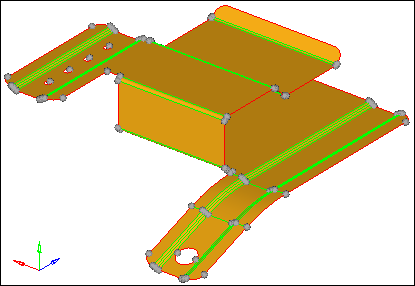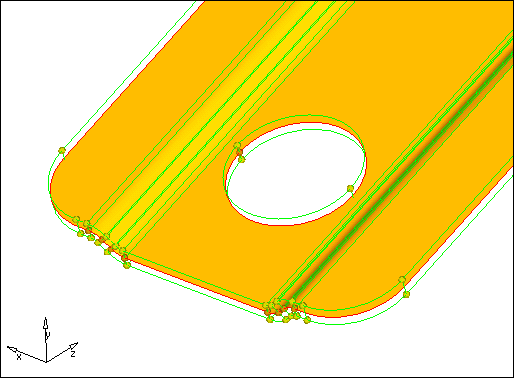HM-2010: Generating a Midsurface |

|

|

|

|
|
HM-2010: Generating a Midsurface |

|

|

|

|
In this tutorial, you will learn how to:
| • | Create a midsurface |
| • | Visualize the midsurface by using shading options and transparency |
This exercise uses CAD geometry data for a thin solid clip. Because of the small thickness of the part, it is assumed that it will be modeled for FEA as shell elements. The elements will be created on the mid-plane of the part.
This exercise uses the clip_midsurface.hm model file, which can be found in the hm.zip file. Copy the file(s) from this directory to your working directory.
The surfaces in this model have no connectivity errors. This could be because the file was imported without errors or because the errors were corrected using HyperMesh. In this case, errors in the topology were repaired in the previous exercise (missing surfaces are re-created, duplicate surfaces are deleted, gaps are closed, and so on). For this tutorial, you can continue using the model you created in tutorial HM-2000, or you can open the new, clip_midsurface.hm, file. Either way, the geometry is at the point where you can use the Midsurface panel to generate a midsurface.
Step 1: Retrieve and view the model file.
| 1. | Open the clip_midsurface.hm model file. |
| 2. | On the Visualization toolbar, click |
| Note: | These visualization techniques will be necessary for viewing the newly created midsurface. |
Step 2: Generate a midsurface from midsurface panel.
| 1. | From the menu bar, click Geometry > Create > Midsurfaces > Auto. |
| 2. | Verify that the closed solid option is selected, and the entity selector is active and set to surfs. |
| 3. | Select one surface. |
| 4. | To start the midsurface generation, click extract. HyperMesh creates the midsurface, and organizes the surfaces into a new Middle Surface component. When HyperMesh creates the midsurface, transparency is turned on for all of the other components in the model except the new Middle Surface component. |
Step 3: Review the part’s midsurface.
| 1. | In the Model browser, only display the Middle Surface component. The graphics area displays the midsurfaces generated for the solid sections of the model using the auto-midsurface panel. |

Midsurface generated from a volume of surfaces
| 2. | In the Model browser, turn the geometry for the lvl10 component back on. |
| 3. | To open the Transparency panel, click |
| 4. | With the comps selector active, select a line or surface of the lvl10 component. HyperMesh selects the entire component because the entity selector is set to comps. |
| Tip: | You may need to zoom in on the model to select a valid entity. |
| 5. | Under transparency, click |
| 6. | Optional: Drag the transparency slider back and forth to control the level of transparency. |
| 7. | To visualize the midsurface, rotate, zoom, and pan. |

Close-up of the midsurface with the lvl10 component set to full transparency
Step 4 (Optional): Save your work.
Now that the midsurface has been created, it is a good time to save the model.
| 1. | From the menu bar, click File > Save > Model. |
You have now created surfaces on the mid-plane of the part. These surfaces can now be meshed or further modifications can be made to their topology, depending on the requirements of the analysis.